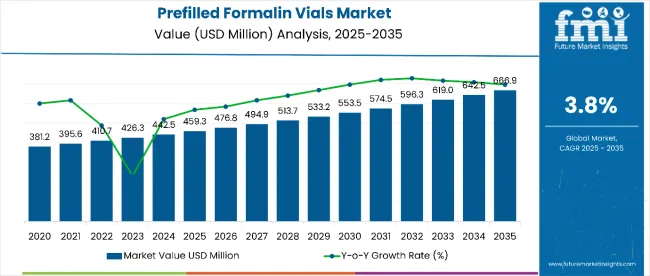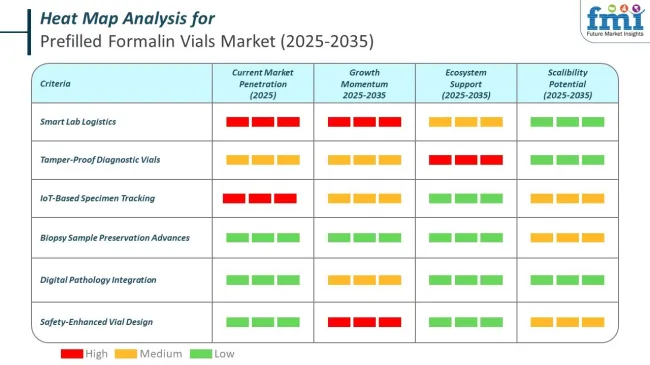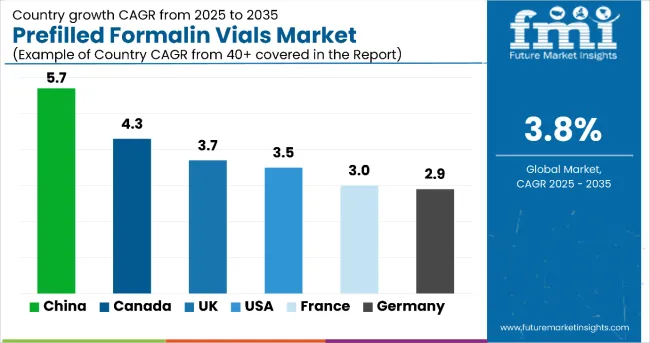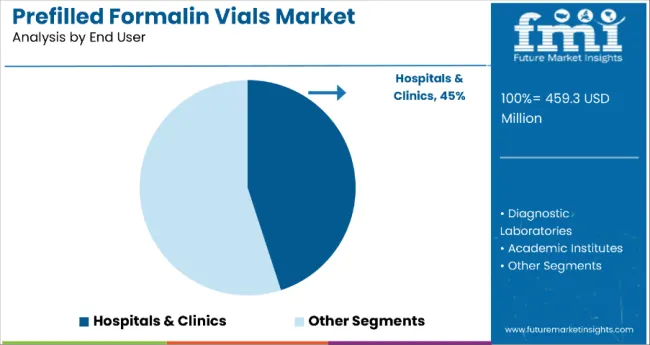The prefilled formalin vials market is estimated to reach USD 459.3 million in 2025. It is estimated that revenue will increase at a CAGR of 3.8% between 2025 and 2035. The market is anticipated to reach USD 666.9 million by 2035.
Formalin is water based clear solution of formaldehyde and methanol. Prefilled formalin vials are used in histopathology, clinical labs, and for research purposes. Formalin is used for accurate fixation of tissue samples. Preserving tissue sample is crucial for diagnostic precision. These vials are available in a range of sizes from less than 10 ml to up to 1 liter.
The 90 to 500 ml size vials are cost effective combined and have sufficient volume due to which they are widely used. Contract research organization is the dominating end user for this product. Hospitals, Emergency Medical Services, Diagnostic Laboratories, Academic Institutes, Veterinary Clinics, etc. are some of the other prominent end users of prefilled formalin vial.

| Attributes | Key Insights |
|---|---|
| Historical Size, 2024 | USD 442.5 million |
| Estimated Size, 2025 | USD 459.3 million |
| Projected Size, 2035 | USD 666.9 million |
| Value-based CAGR (2025 to 2035) | 3.8% |
Rising prevalence of cancer and chronic diseases has led to increased demand for tissue biopsies. These biopsies are crucial for diagnosis and histopathological analysis. Preserving tissue sample in formalin solution is required for the same. This has led to increase demand for formalin solution. Various regulatory authorities has laid guidelines for tissue preservation protocol.
Manual preparation of formalin results in variability in concentration. Using prefilled formalin solution solves this problem. Laboratories can efficiently manage their workflow and using prefilled formalin is also cost effective. Prefilled vials allows research firms to comply with the regulations and established standardized tissue preservation practices in the industry.
The market faces challenges due to the high cost of latest vial design and competition from the alternative solution. Advanced vials equipped with smart labeling, RFID tags, and tamper-proof designs often come with a higher price tag. Smaller laboratories with limited budget cannot opt for this solution.
There have been growing awareness about the health hazard of handling the formalin solution. Coupled with the sustainability trend this factor is driving the adoption of formalin-free alternatives, which is hampering the market growth of formalin.
Developing regions such as Asia-Pacific, Latin America, and parts of the Middle East are witnessing rapid advancements in healthcare infrastructure and increasing investments in diagnostic capabilities. These regions present untapped growth potential for prefilled formalin vial manufacturers.
Companies that can strategically establish distribution networks, form local partnerships, and ensure cost-efficient production will be well-positioned to capture significant market share in these regions. Incorporating technological advancements such as smart labeling systems, automation-compatible designs, and precision dosing mechanisms has further enhanced the utility and efficiency of prefilled formalin vials.
In 2025, the market is seeing a stronger pull from digital pathology adoption. Vials are now expected to work seamlessly with automated specimen processors. OEMs are embedding QR or RFID tech to enable compatibility with LIS (Laboratory Information Systems). The goal is uninterrupted flow from biopsy room to diagnosis station.
The market is undergoing rapid automation, from fill-volume precision to end-to-end sample tracking. Labs are adopting AI-powered scanners and smart labeling to reduce errors and improve compliance. Robotics is minimizing human exposure while enhancing throughput in diagnostic workflows.
In 2025, demand for standardized and traceable specimen workflows is driving adoption of predictive and connected systems. Institutions like the USDA and Iowa State are testing edge sensors and digital twins to enhance vial transport reliability. Real-time alerts are enabling rapid response to deviations in storage and temperature.

The below table presents the expected CAGR for the global growth of prefilled formalin vials sales over several semi-annual periods spanning from 2024 to 2034. In the first half (H1) of the decade from 2024 to 2034, the business is predicted to surge at a CAGR of 4.8%, followed by a slightly lower growth rate of 4.3% in the second half (H2) of the same decade.
| Particular | Value CAGR |
|---|---|
| H1 | 4.8% (2024 to 2034) |
| H2 | 4.3% (2024 to 2034) |
| H1 | 3.8% (2025 to 2035) |
| H2 | 3.3% (2025 to 2035) |
Moving into the subsequent period, from H1 2025 to H2 2035, the CAGR is projected to decrease slightly to 3.8% in the first half and remain relatively moderate at 3.3% in the second half. In the first half (H1) the market witnessed a decrease of 100 BPS while in the second half (H2), the market witnessed a decrease of 100 BPS.
Increased Prevalence of Cancer and Subsequent Biopsies Volume Drive Growth of Prefilled Formalin Vials Market
Cancer remains a leading cause of mortality worldwide. According to the data from International Agency for Research on Cancer (IARC) there were 20 million new cancer cases in 2022. The mortality for the same year due to cancer was 9.7 million. Accurate diagnosis followed by treatment planning is crucial for managing the growing prevalence of cancer.
This step requires histopathological analysis where high-quality tissue samples are preserved in formalin. For laboratories preparing their own formalin solution can lead to variability in concentration and increases operational complexity. Using prefilled formalin vials not only solves the above problem but it is also more cost-effective.
Apart from cancer diagnosis other diseases such as autoimmune disorders, cardiovascular disease etc. also require tissue biopsies. The rise in early cancer screening programs with focus on preventive healthcare have amplified the demand for sample preservation products. Governments and healthcare organizations are actively promoting early detection campaigns.
This initiatives is leading to an increase in biopsy volumes. The advancements in precision medicine have also increased the need for standardized tissue samples. Formalin-fixed tissues are essential in identifying genetic mutations and disease markers which are critical for advanced therapeutic strategies. The growing chronic disease prevalence and rising demand for personalized medicine is driving the market growth.
Rise in Diagnostic Procedure and Clinical Trials Increased the Demand for Cardiovascular Prefilled Formalin Vials
Various diagnostic procedure for chronic disease required tissue sample. Extensive test are conducted on tissue sample during clinical trials. Any compromise in tissue preservation lead to inaccurate results. Prefilled formalin vials address these challenges by offering a standardized method for tissue fixation.
Regulatory bodies, have implemented strict guidelines for tissue sample handling. The guidelines highlights fixation ratios and formalin concentration levels. These regulations ensure uniformity reducing the chances of errors caused by manual preparation of formalin solutions.
Prefilled formalin vials comply with these standards by offering pre-measured, contamination-free, and accurately concentrated solutions. Using prefilled formalin vial reduces the risk of variability in tissue preservation.
The adoption of prefilled formalin vials addresses safety concerns associated with manual formalin handling. Formalin is a hazardous chemical. Exposure of its fumes poses health risks to laboratory personnel. Standardization improves operational efficiency in high-throughput laboratories.
Prefilled vials save time along with reducing likelihood of human error. It also enables the laboratories to streamline their process enabling them to handle larger sample volumes. This advantage of using prefilled formalin over the manually preparing the formalin is driving the market growth.
Advancement in Vial Design Increased the Opportunity for Market Growth
The integration of RFID tags and smart barcoding systems enhances sample traceability. This innovation ensures every tissue sample is accurately labeled, tracked, and processed. Using RFID significantly reduces errors in sample identification which is a critical factor in pathology and research workflows.
Laboratories adopting these smart solutions experience improved operational efficiency. Using leak-proof and tamper-evident designs for prefilled formalin vial not only enhance user safety by minimizing exposure to hazardous formaldehyde fumes but also ensure the chemical integrity of the solution.
Adoption of vapor sealed technologies further addresses growing concerns about the occupational hazards associated with formalin use. These improvements make prefilled vials safer for laboratory personnel and environmentally sustainable, aligning with global health and safety regulations.
Moreover, automation-compatible vial designs streamline workflows in laboratories utilizing robotic systems and automated sample processors. This reduces manual intervention, minimizes human errors, and boosts overall productivity, making these vials indispensable in large-scale operations.
Collectively, these technological advancements cater to the pressing needs of healthcare facilities by offering enhanced safety, compliance, efficiency, and traceability. As healthcare and research sectors continue to embrace digital transformation and automation, the demand for prefilled formalin vials is expected to grow exponentially.
High Cost of Vials with Advance Features Hinder the Market Growth
The high cost of prefilled formalin vials is hindering the market growth. Small scale laboratories and healthcare facilities have limited budgets. Prefilled vials especially those incorporating advanced features such as RFID technology, tamper-evident seals, leak-proof caps, and automation compatibility are expensive. The initial investment required for purchasing these specialized vials prohibits the adoption of same by smaller entities.
Due to the hazardous nature of formalin solution there have been shift in focus toward alternatives tissue preservative solutions. Formaldehyde-free preservation solutions, ethanol-based solutions, or other eco-friendly options are increasingly being adopted.
These alternatives are often perceived as safer which adds another layer of competition for prefilled formalin vials. These alternatives are seen as a more sustainable and cost-effective option for certain markets.
As a result, the demand for formalin-based solutions may be negatively impacted. Additionally, the cost of prefilled formalin vials is influenced by factors such as raw material costs, production processes, and logistics, all of which contribute to the overall price.
This high price point deter adoption, especially in countries with cost-sensitive healthcare systems or low-budget research settings, where more affordable tissue preservation options are being sought. As a result, while prefilled formalin vials offer advanced benefits, their high cost limits widespread adoption in certain markets.
The sales of prefilled formalin vials recorded a CAGR of 3.8% between 2020 and 2024. According to the industry, prefilled formalin vials generated USD 442.5 million in 2024, up from USD 381.2 million in 2020.
Initially laboratories prepared formalin solution manually. There were several challenges to it. There is high possible of variation in formalin concentration between the batched. Most laboratories operated on small scale which led to multiple preparation cycle and small batches which increased the risk of variability in concentration.
Also preparing formalin exposes healthcare workers to hazardous chemicals. Also the tissue preservation protocol were not standardized which hindered the wide spread adoption of prefilled formalin vails.
As the healthcare industry grew and globalization surged the emphasis of standardization increased. The increasing prevalence of cancer, and chronic diseases resulting in rising biopsy volumes has fueled the demand for reliable tissue preservation solutions.
FDA, EMA, and CAP, have imposed stringent guidelines for tissue sample handling, ensuring compliance with best practices in healthcare setting. Technological advancements in vial designs with leak-proof seals and better chemical stability further enhanced product adoption.
The prefilled formalin vial market is expected to grow steadily, due to automation, smart vial technologies, and sustainable packaging solutions. The integration of barcode tracking and RFID technology on vials will improve sample traceability and reduce identification errors.
Additionally, there is a rising focus on environmentally friendly formalin alternatives and reduced exposure risk for lab personnel, which will lead to innovations in chemical formulations.
Companies in the Tier 1 sector account for 48.5% of the global market, ranking them as the dominant players in the industry. Tier 1 players’ offer a wide range of product and have established industry presence. Having financial resources enables them to enhance their research and development efforts and expand into new markets.
A strong brand recognition and a loyal customer base provide them with a competitive advantage. Prominent companies within Tier 1 include Cardinal Health, Inc., Leica Microsystems Sales GmbH, Genta Environmental Ltd., and others
Tier 2 players dominate the industry with a 33.5% market share. Tier 2 firms have a strong focus on a specific Product and a substantial presence in the industry, but they have less influence than Tier 1 firms.
The players are more competitive when it comes to pricing and target niche markets. New Product and services will also be introduced into the industry by Tier 2 companies. Tier 2 companies include Diapath S.p.A, Histo- Line Laboratories Srl, Carl Roth GmbH + Co. KG, and others.
Compared to Tiers 1 and 2, Tier 3 companies have smaller revenue spouts and less influence. Those in Tier 3 have smaller work force and limited presence across the globe. Prominent players in the tier 3 category are Magnacol Ltd., Serosep Limited, Ultident Scientific, Solmedia Limited, and others.
The section below covers the industry analysis for the prefilled formalin vials market for different countries. Market demand analysis on key countries in several regions of the globe, including North America, Latin America, East Asia, South Asia and Pacific, Western Europe, Eastern Europe, and Middle East and Africa (MEA), is provided.
The United States is anticipated to remain at the forefront in North America through 2035. India is projected to witness a CAGR of 4.6% from 2025 to 2035.

| Countries | Value CAGR (2025 to 2035) |
|---|---|
| USA | 3.5% |
| Canada | 4.3% |
| Germany | 2.9% |
| Italy | 2.8% |
| France | 3.0% |
| UK | 3.7% |
| Spain | 2.6% |
| China | 5.7% |
Each year millions of tissue biopsies are conducted within United States. The reason for this high number of biopsies are constantly growing cancer prevalence along with other chronic diseases. Biopsies serves as a definition diagnostic procedure.
The USA healthcare system is heavily focused on advanced diagnostic techniques, precision medicine, and early disease detection. All of which require high quality tissue samples. Formalin is required for preserving the tissue and using prefilled formalin vial improved the operational efficiency and are cost effective for the organization conducting the research.
The United States is also home to world leading healthcare companies from pharma and biopharma giants to the CROs. Food and Drug administration and College of American Pathologists mandate tissue preservation protocols that require formalin solution.
The strong emphasis on clinical trials and biomedical research in the USA ensures consistent demand for tissue preservation products. Hence, the country has huge growth prospect for prefilled formalin vial due multiple demand side and supply side factors.
Germany has a well-developed healthcare infrastructure and robust research ecosystem. The country is home to leading diagnostic laboratories, academic research institutions, and pharmaceutical companies. All of these settings require reliable tissue preservation solutions.
There is a strong emphasis on pathology and cancer research. This research is conducted in university and non-university settings. The spectrum spans from monothematic working groups to large interdisciplinary departments.
Additionally, stringent European Union regulations regarding sample handling, safety, and compliance drive the adoption of prefilled formalin vials. The main focus here to ensure standardization and minimize human error. Germany's proactive approach to technological adoption in healthcare facilities and laboratories further enhances market growth.
The increasing geriatric population and rising cancer cases have driven higher biopsy and tissue sampling volumes directly boosting demand for formalin. As the demand for tissue preservation increases due to multiple reasons the market for prefilled formalin vail is bound to grow.
Japan has one of the world’s most rapidly aging populations. The high geriatric population has led to an increase in age-related diseases, including cancer. This demographic shift has significantly raised the demand for histopathological studies and biopsies.
Both of these applications require reliable tissue fixation solutions. Japan is a global leader in medical research and technological innovation. The country has heavily invested in pathology, oncology research, and clinical trials. The market condition has heighten the demand for prefilled formalin vials.
The demand is further bolstered by the regulatory norms requiring the research institute to follow stringent protocol to preserve tissue samples. Institute can formulate their own formalin solution but using prefilled formalin vial is efficient and cost-effective.
According to the data from clinicaltrial.gov more 10,000 clinical trials are conducted in Japan. There around 1,500 active clinical trial. 70% for phase 3 trial make it thorugh the market approval. As the clinical trial market grows in Japan the demand for prefilled formalin vail continue increasing.

The 90 - 500 mL segment holds a significant position with 23.4% of the market share in the product type category within the prefilled formalin vials market. This segment's prominence is driven by the optimal volume range that meets the majority of standard tissue specimen preservation requirements in pathology laboratories and clinical settings.
The 90 - 500 mL capacity provides adequate formalin volume for medium to large tissue samples while maintaining cost-effectiveness and storage efficiency for healthcare facilities.
The segment's market position is reinforced by its versatility in accommodating various specimen types, from routine biopsies to surgical resections, making it a preferred choice for general pathology applications.
These vials offer the ideal balance between specimen-to-fixative ratio requirements and practical handling considerations for laboratory technicians. As diagnostic procedures become more standardized and specimen processing volumes increase, the 90 - 500 mL segment is positioned to maintain its substantial market share through continued optimization of vial design and formalin quality standards that support accurate histopathological analysis.

Hospitals & clinics dominate the prefilled formalin vials market with 45% of the market share, reflecting their role as primary sources of tissue specimens requiring formalin fixation for diagnostic pathology services.
This segment's leadership is attributed to the high volume of surgical procedures, biopsies, and diagnostic tissue sampling performed in hospital and clinical settings that require immediate and reliable specimen preservation. Hospitals and clinics benefit from prefilled formalin vials' convenience, standardized quality, and reduced preparation time compared to traditional formalin mixing procedures.
The segment encompasses applications across various medical specialties including oncology, gastroenterology, dermatology, and general surgery where tissue specimens must be properly preserved for accurate histopathological diagnosis.
The growing emphasis on rapid turnaround times, quality assurance, and laboratory efficiency is driving sustained demand for prefilled formalin solutions that eliminate preparation variability and ensure consistent specimen fixation.
As healthcare systems prioritize diagnostic accuracy and operational efficiency, the hospitals & clinics segment is expected to maintain its dominant market position through continued investment in standardized specimen processing protocols and quality management systems that support optimal patient care outcomes.

Key industry players are prioritizing the product development such as leak-proof seal and tamper evident designs. Companies are collaborating with healthcare institutions and laboratories to increase their market penetration. Another strategy to increase the product adoption within the developing country is to appoint partner with local distributors.
In terms of product, the industry is segmented into <10 mL, 10 - 20 mL, 20 - 40 mL, 40 - 60 mL, 60 - 90 mL, 90 - 500 mL, and 500 mL - 1 Litre.
In terms of end user, the industry is segmented into hospitals, clinics, emergency medical services, diagnostic laboratories, academic institutes, forensic laboratories, contract research organizations, veterinary clinics, veterinary laboratories, and veterinary hospitals.
Key countries of North America, Latin America, Western Europe, Eastern Europe, South Asia and Pacific, East Asia, the Middle East, and Africa have been covered in the report.
The sales of Prefilled Formalin Vials is expected to increase at a CAGR of 3.8% between 2025 and 2035.
The 90 - 500 mL segment is expected to occupy a 23.4% market share in 2025.
The sales of prefilled formalin vials is expected to reach USD 666.9 million by 2035.
The United States is forecast to see a CAGR of 3.5 % during the assessment period.
The key players in this sector include Diapath S.p.A, Histo- Line Laboratories Srl, Cardinal Health, Inc., Leica Microsystems Sales GmbH, Genta Environmental Ltd., Carl Roth GmbH + Co. KG, Magnacol Ltd., Serosep Limited, Ultident Scientific, Solmedia Limited, and Others.






Full Research Suite comprises of:
Market outlook & trends analysis
Interviews & case studies
Strategic recommendations
Vendor profiles & capabilities analysis
5-year forecasts
8 regions and 60+ country-level data splits
Market segment data splits
12 months of continuous data updates
DELIVERED AS:
PDF EXCEL ONLINE
Prefilled Syringe Drug Molecule Market Analysis - Size, Share, and Forecast 2025 to 2035
Europe Glass Prefilled Syringes and Glass Vials Packaging Equipment Market Analysis – Outlook & Forecast 2025–2035
Polymer-based Prefilled Syringe Market Growth & Healthcare Trends 2024-2034
Formalin Market Size and Share Forecast Outlook 2025 to 2035
Formalin Vials Market Size and Share Forecast Outlook 2025 to 2035
Micro Vials Market Size and Share Forecast Outlook 2025 to 2035
Serum Vials Market Size and Share Forecast Outlook 2025 to 2035
Shell Vials Market Size and Share Forecast Outlook 2025 to 2035
Plastic Vials and Ampoules Market Size and Share Forecast Outlook 2025 to 2035
Polymer Vials Market Insights & Industry Growth 2025 to 2035
Leading Providers & Market Share in Plastic Vials and Ampoules Industry
Flip Top Vials Market Size and Share Forecast Outlook 2025 to 2035
Cosmetic Vials Market Trends - Size & Growth 2025 to 2035
Snap Cap Vials Market
Interlock Vials Market Size and Share Forecast Outlook 2025 to 2035
Cryogenic Vials and Tubes Market Size and Share Forecast Outlook 2025 to 2035
Market Share Distribution Among Interlock Vials Manufacturers
Diagnostic Vials Market Size and Share Forecast Outlook 2025 to 2035
Breaking Down Diagnostic Vials Market Share & Industry Insights
Speciality Vials Market

Thank you!
You will receive an email from our Business Development Manager. Please be sure to check your SPAM/JUNK folder too.
Chat With
MaRIA